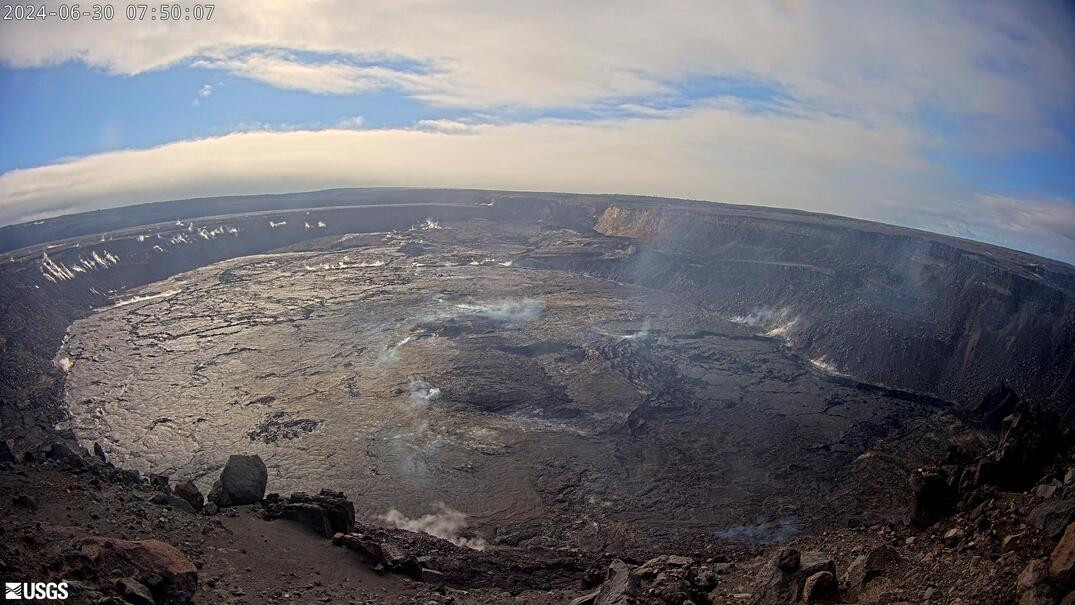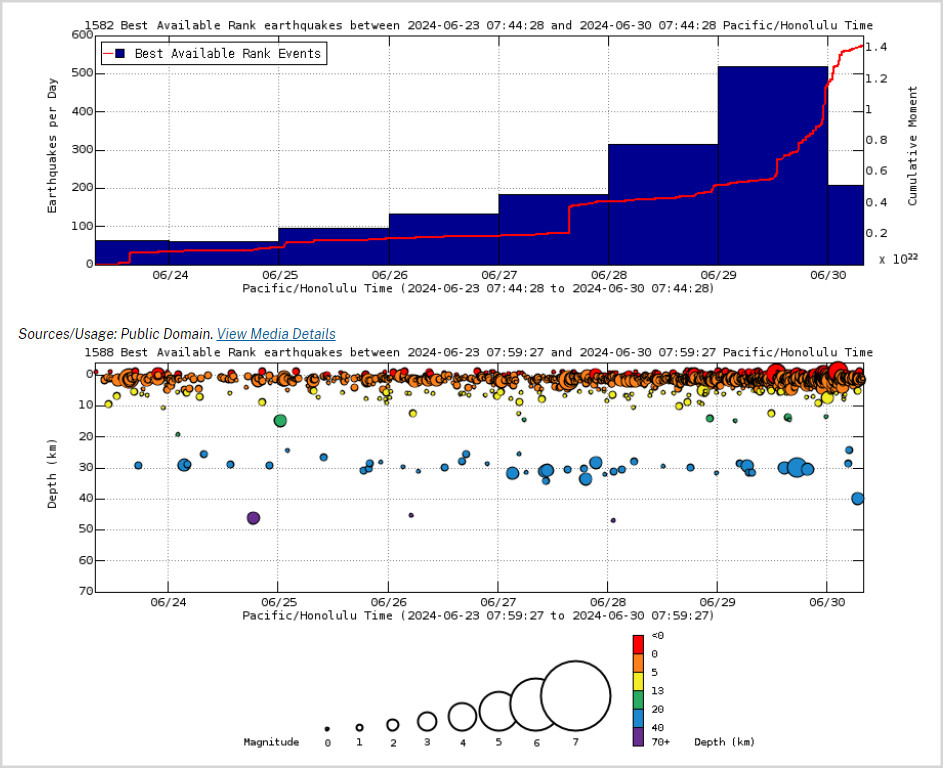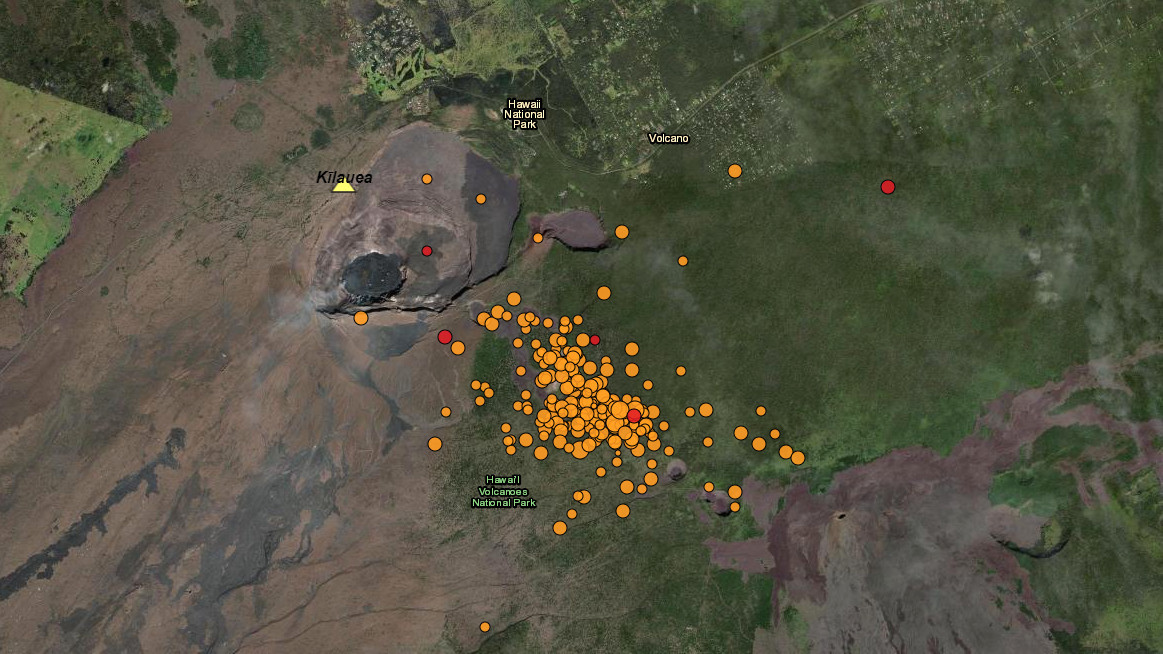
USGS webcam showing a panorama of Halemaʻumaʻu and down-dropped caldera floor from the west rim of the Kīlauea summit caldera on Sunday morning.
(BIVN) – Kīlauea volcano is not erupting, although a seismic swarm is currently ongoing within Kīlauea’s upper East Rift Zone.
Hundreds of earthquakes have occurred over the past day, with rates reaching approximately 30 events per hour.
UPDATE – (8:45 a.m.) – Scientists say “any substantial increases in seismicity and/or deformation could result in a new eruptive episode, but there are no signs of an imminent eruption at this time.”
The current USGS Volcano Alert Level remains at ADVISORY.
In a status report issued at 1:43 a.m. HST by the USGS Hawaiian Volcano Observatory, scientists detailed the elevated earthquake activity.
Here is the full statement by the USGS HVO:
Activity Summary: Kīlauea’s upper East Rift Zone, beneath Chain of Craters Road within Hawaiʻi Volcanoes National Park, has been experiencing a seismic swarm that began in the afternoon of June 27. Late in the evening of June 29, the intensity of seismicity escalated, with earthquake rates reaching approximately 30 events per hour. Most of the earthquakes are centered in the region between Puhimau Crater and the Hilina Pali Road intersection at depths of 1.5–3 km (1–1.8 mi), but they also extend north toward Keanakākoʻi Crater and south to Pauahi Crater. The largest earthquake in the swarm has been a magnitude-3.0 that occurred at 1:03 a.m. HST just north of Hiʻiaka crater at a depth of 3 km (2 mi). Although the summit region has been inflating since the end of the June 3, 2024, eruption southwest of the summit, there have been no significant changes in ground deformation associated with this escalation of seismicity.
In its second Sunday morning update, the USGS HVO noted the earthquake rate has slowed to approximately 20 earthquakes per hour, “which still represents heightened unrest compared to before the June 27 swarm.”

Above Top: Number of earthquakes per day during the past week (blue bars). The red line is the cumulative moment (energy) release. Bottom: Depth of earthquakes during the past week in the area shown on the map above. Depth is reported relative to sea level, which is equal to a depth of zero on the above plot. On both figures, circle-size represents magnitude, and color indicates depth. (USGS graphs)
Analysis: Following the eruption on June 3, 2024, magma has been repressurizing the storage system beneath Halemaʻumaʻu and the south caldera region, activating earthquakes in the upper East Rift Zone and in the caldera south of Halemaʻumaʻu. At this time, it is not possible to say whether this increase in activity will lead to an intrusion or an eruption in the near future, or simply continue as seismic unrest at depth. Previous eruptions and intrusions beneath the upper East Rift Zone have occurred in the vicinity of Pauahi Crater and Hiʻiaka Crater to the southeast and around Luamanu and Keanakākoʻi Craters at the margin of the caldera. This region erupted several times during the 1960s–1970s; the most recent eruption took place over a single day in November 1979 within and near to Pauahi Crater.
Currently, there is no indication that magma is moving towards the June 3, 2024, eruption site southwest of the caldera. However, changes in the character and location of unrest can occur quickly, as can the potential for eruption.
The USGS HVO says it will continue to provide daily updates for Kīlauea volcano. If activity change significantly, a Volcanic Activity Notice will be issued.


by Big Island Video News8:38 am
on at
STORY SUMMARY
HAWAIʻI VOLCANOES NATIONAL PARK - Hundreds of earthquakes are occurring in Kīlauea's upper East Rift Zone, prompting an overnight status report from the USGS.